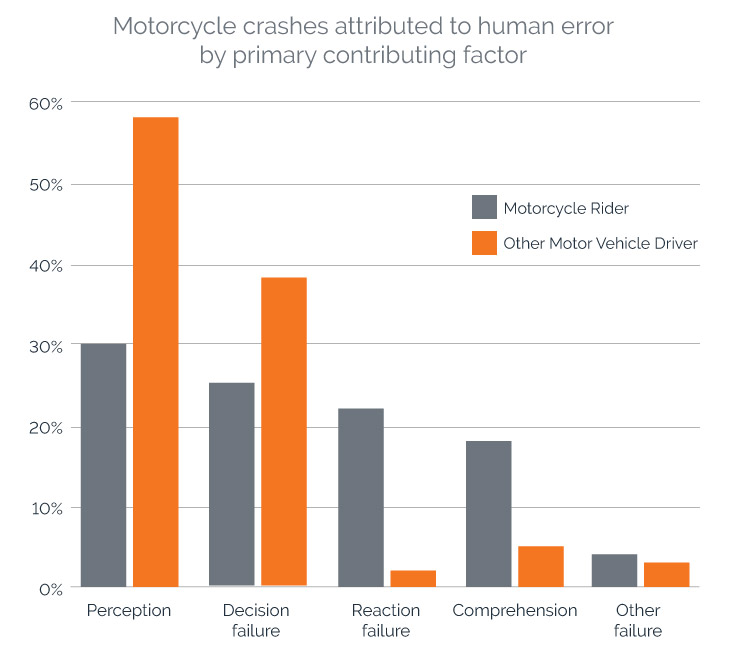
Know your rights and obligations in a motorcycle crash lawsuit
From the historic Grand Army of the Republic Highway to the Michaux State Forest Loop, Pennsylvania is crawling with scenic motorcycle-riding routes.
With so many beautiful routes, it’s unsurprising that there were 835,787 registered motorcycles in Pennsylvania in 2018. This number doesn’t include the motorcycles registered out-of-state that enter the Keystone State to visit sights like Gettysburg and the beaches of Presque Isle.
Unfortunately, Pennsylvania regularly finds itself in the top 10 states for motorcycle accidents.
Let’s take a look at what you need to know if you’re involved in a motorcycle crash in Pennsylvania.
Motorcycle accident statistics
| Pennsylvania motorcyclist fatalities and injuries | |||||
|---|---|---|---|---|---|
| Outcome | 2014 | 2015 | 2016 | 2017 | 2018 |
| Fatalities | 186 | 179 | 192 | 185 | 164 |
| Injuries | 3,207 | 3,312 | 3,321 | 3,052 | 2,611 |
Source: Pennsylvania Department of Transportation
In 2018, motorcycle crashes represented just 2.1% of all crashes in Pennsylvania. However, motorcycle crashes represented 14.4% of all fatal crashes.
Common causes of motorcycle accidents
A number of studies have examined the causes of motorcycle accidents in the US. Most of these studies found that the vast majority of motorcycle crashes occur at intersections and result from human error (attributed either to the motorcycle rider or the driver of another vehicle).
A small percentage of crashes are the result of vehicle problems (such as mechanical defects) or environmental factors (such as adverse weather).
A study conducted by the National Transportation Safety Board examined the risk factors associated with motorcycle crashes across the U.S. and found the following data:

Source: National Transportation Safety Board
Is drunk driving a problem among motorcyclists in Pennsylvania?
Yes. In 2018, motorcyclists had the largest percentage of intoxicated drivers involved in crashes.
According to the Pennsylvania Department of Transportation (PennDOT), there were 2,722 crashes involving motorcyclists in 2018. Of those crashes, alcohol was a factor in 288 (10.4%). Compare this to passenger car accidents, in which alcohol was a factor in only 4.8% of crashes.
Just like other motor vehicle drivers, a motorcyclist will receive a DUI in Pennsylvania if their blood-alcohol content (BAC) is above .08%. If the motorcyclist is under 21, Pennsylvania has a “zero tolerance” law, which means the unerage motorcyclist will be charged with a DUI if they have any alcohol in their system.
Pennsylvania motorcycle laws
In general, motorcyclists have the same rights and duties as other motor vehicle drivers. However, Pennsylvania has passed a number of laws specifically designed to keep motorcyclists safe. Most of these laws can be found in Chapter 35 of the Pennsylvania Vehicle Code.
Let’s take a closer look at a few you should know before you get behind the handlebars.
License requirements
If you suddenly decide you want to ride a motorcycle, you can’t just purchase a brand new Harley Davidson, tuck your regular driver’s license into your wallet, and pop a wheelie.
To operate a motorcycle in Pennsylvania, operators must have a valid driver’s license with a Class M designation, or have a valid motorcycle permit while riding with an approved supervisory rider.
Helmet laws
Pennsylvania requires most motorcyclists and their passengers to wear protective headgear that meets the U.S. Department of Transportation (USDOT) Standards (indicated by the “DOT” sticker on the helmet).
Only the following people are not required to wear a motorcycle helmet in Pennsylvania:
- The operator or any occupant of a 3-wheeled motorcycle equipped with an enclosed cab
- A person 21 years of age or older who has been licensed to operate a motorcycle for at least 2 full calendar years
- A person 21 years of age or older who has completed a motorcycle rider safety course approved by the PennDOT or the Motorcycle Safety Foundation
NHTSA estimates that helmets saved the lives of 1,870 motorcyclists in 2017, and that 750 more lives across the country could have been saved if all motorcyclists had worn helmets.
Lane Splitting
Lane splitting is when a motorcyclist rides between 2 lanes of cars heading in the same direction.
Motorcyclists generally split lanes on the highway when traffic slows, but some riders also split lanes in order to filter to the front of traffic at a stoplight.
There’s a lot of debate about whether lane splitting is safe or not. Some states have taken the approach that it’s not safe and have passed laws to prohibit lane splitting. Other states allow lane splitting.
In Pennsylvania, lane splitting is strictly prohibited. Specifically, no person is allowed to operate a motorcycle between lanes of traffic or between adjacent lines or rows of vehicles.
Other rules for motorcyclists
Other important “road behavior” motorcycle laws in Pennsylvania include:
- Motorcyclists are prohibited from riding more than 2 abreast in a single lane.
- A person operating a motorcycle must use the permanent and regular seat attached to the motorcycle, and the operator is prohibited from carrying any other person on a motorcycle unless the motorcycle is designed to carry more than 1 person.
- No person shall operate a motorcycle while carrying any package, bundle or other article that prevents the rider from keeping both hands on the handlebars.
Motorcycle insurance requirements
No-fault and fault-based insurance systems refer to a state’s rules for how a motorcycle accident victim is required to handle the claims-filing process.
- No-fault insurance systems. In states with a no-fault insurance system, all riders in an accident—no matter who’s responsible—turn to their own insurance policies to cover the damages.
- Fault-based insurance systems. In states with a fault-based insurance system, the person responsible for causing a motorcycle accident is also responsible for paying the damages.
Pennsylvania is different than most states because it doesn’t have a no-fault or fault-based system.
Rather, it’s up to each rider to decide whether to purchase no-fault insurance (sometimes called “limited tort” insurance coverage) or fault-based insurance (sometimes called “full tort” insurance coverage).
There are advantages and disadvantages to each type of coverage. The most important thing to keep in mind is that, with very few exceptions, you can’t file a lawsuit against the at-fault person if you have no-fault insurance. Instead, you’re limited to filing a claim with your own insurer.
Just like other motor vehicle drivers, all motorcyclists in Pennsylvania are required to carry liability insurance. Liability insurance covers bodily injuries and property damage caused by the insured individual and sustained by someone other than the insured.
The required minimum amounts of liability coverage in Pennsylvania are:
- $15,000 for bodily injury or death of 1 person in an accident
- $30,000 for total bodily injury or death in an accident (i.e., for all persons harmed in 1 accident)
- $5,000 for property damage per accident
Who’s liable in a motorcycle accident?
Assuming you have fault-based insurance, you’ll want to know who’s at fault following a motorcycle accident.
Pennsylvania motorcyclists and other motor vehicle drivers have a duty to exercise reasonable care to avoid injuring others on the road. If this duty is violated, the motorcyclist or motor vehicle driver will likely be found negligent (i.e., at fault).
Examples of actions that might result in a motorcyclist or motor vehicle driver being found negligent include:
- Drunk driving
- Distracted driving
- Running a red light
- Turning into oncoming traffic
- Lane splitting
- Following too closely
What happens if both the plaintiff and the defendant are at fault for a motorcycle accident?
Pennsylvania follows the modified comparative fault rule. Under this rule, the plaintiff’s damages are reduced by the plaintiff’s degree (or percentage) of fault. What’s more, if the plaintiff is more than 50% at fault, they are prohibited from recovering any damages.
Common motorcycle crash injuries
Motorcyclists are much more likely than passenger car occupants to die or become seriously injured in a crash.
Common motorcycle injuries include:
What damages are available in a motorcycle accident?
If you’re injured in a motorcycle accident in Pennsylvania, you can seek both economic and non-economic damages.
Economic damages have a price tag, and include compensation for costs such as:
- Medical expenses (past and future)
- Lost wages (past and future)
- Property repair or replacement
Non-economic damages don’t have a specific dollar value, and include reimbursement for:
- Pain and suffering
- Loss of consortium
- Emotional distress
- Loss of enjoyment of life
Pennsylvania motorcycle accident statute of limitations
The term “statute of limitations” refers to a law that sets a time limit on your right to file a lawsuit. If you fail to file your lawsuit within this time limit, your case will be dismissed.
In Pennsylvania, most motorcycle accident lawsuits (whether based on property damage or physical injuries) must be brought within 2 years of the accident.
Motorcycle safety and accident prevention tips
PennDOT offers 4 general tips for staying safe on a motorcycle:
- Wear the right gear. Wear a helmet at all times, even if you’re not required to by law. In addition, be sure the helmet meets the U.S. Department of Transportation standards. Helmets with a label from the Snell Memorial Foundation give you an added assurance of quality.
- Get familiar with your motorcycle. Motorcycle crashes are higher among “borrowed” motorcycles. If you’re borrowing a motorcycle, take the time to familiarize yourself with the controls. Spend some time riding in a safe area (such as a parking lot) before taking to the roads.
- Check the motorcycle equipment. Frequent maintenance is important for motorcycle riders. On a motorcycle, a minor technical failure can have catastrophic results.
- Be a responsible rider. Driving aggressively greatly increases your chances of crashing. Follow the speed limits, communicate your intentions, maintain adequate space, avoid lane splitting and always ride within your abilities.
Looking for additional safety resources? Consider the following:
- Pennsylvania Helmet Law Fact Sheet
- Pennsylvania Motorcycle Safety Program Fact Sheet
- Motorcycle Operator Manual
- National Association of State Motorcycle Administrators
- Pennsylvania Motorcycle Safety Program
If you or a loved one has been injured in a motorcycle crash, don’t risk missing out on receiving the compensation you deserve. Use our free legal directory to locate an experienced Pennsylvania attorney in your area.
See our guide Choosing a personal injury attorney.
